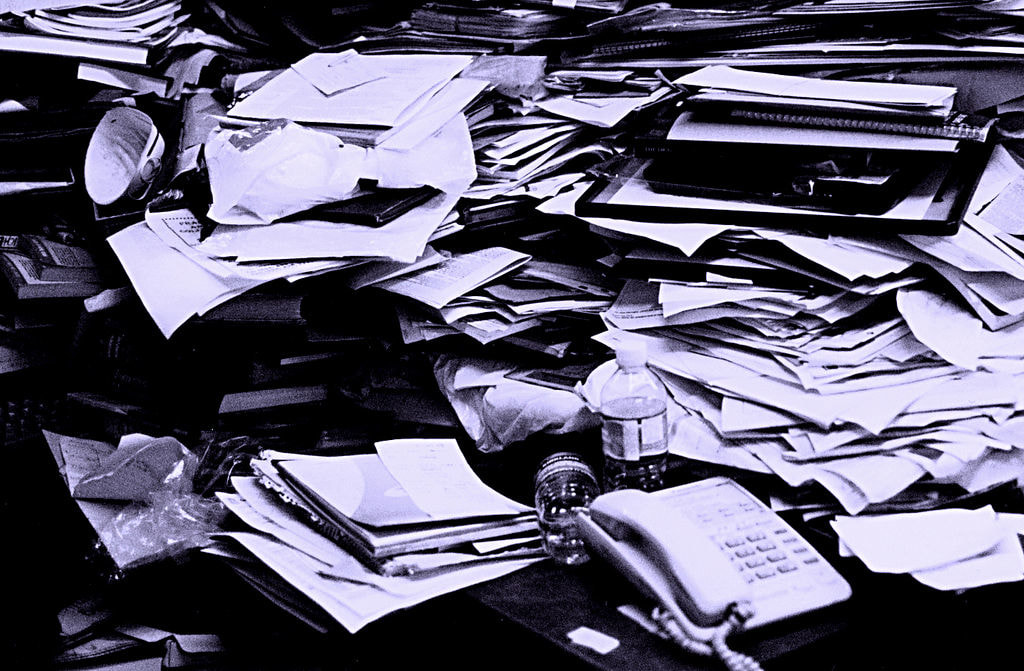There are some common types of storage available in nearly all offices: desk drawers, wall shelves, shelving units and cupboards, to name the most common ones. Below that first layer of storage, a number of different systems have been developed to keep stuff from mixing: hanging files (for desk drawers and cupboards), soft folders, hard binders and trays. We’ll leave aside the classic ‘paper pile’ as that does not really count as a useful way of storing things. Wink wink, nudge nudge.
If anything, there is a lot of choice, but when we try to store the diverse set of items usually present in an office into those options, we’ll soon run into a number of new issues: shelves may be fine to put reams of paper on, but piles of envelopes will quickly start to slip and mix. A hanging file may be useful, but what if the contents grow to a point that a hanging file won’t fit them all at once? What about that box of staples that keeps going forever but gets lost on its shelf? The trick here is to realise that one size never quite fits everything, and while a decision for, e.g., cupboards with hanging files, might look perfect when you start out, it becomes a bit of a problem when you realise that you also need shelves to put reams of paper and the staple supplies on. As usual, a mix of storage is helpful and here are some tips to consider. Trays are useful for anything paper-related, short-term (like the filing trays on the desk) or regularly used materials (like letterhead paper or marketing materials). Since trays are flexible, they can be placed anywhere, including shelving units (open) or in cupboards (can be locked up). In general, I recommend trays for things that move in a one-way direction, i.e. only ‘in’ for temporary storage, then ‘out and never back’ to be used or filed away for reference. Hanging files are the next step for papers. Like trays, they are made for easy access and quick addition of new materials. However, like trays, the contents of hanging files tend to get mixed up due to the unfixed nature of the contents. Take one piece of paper out of its place and you’ll have a hard time putting it back exactly in the same place. This being said, hanging files are brilliant to bring things together, if not in a particular order. The fact that you can simply drop a document into a file saves a lot of time in storage, but might be an issue when trying to retrieve something. Hard binders usually standing upright on shelves and contain papers of a more permanent nature, in a particular order and separation. As you can already see, binders are more useful for retrieval due to their more organised structure, but they will take a little more time for filing than hanging files because of that same structure. Therefore, hard binders are usually used for long-term storage rather than instant retrieval. Think ‘reference file’ rather than ‘daily use’. Soft folders are a bit of a compromise between hanging files and hard binders. There a two main types: either they have a flap and look like the love child of a hanging file and an envelope, or they have their own binding system, which makes them more of a soft-shell version of a hard binder. Really, both are portable version of their ‘parents’: hanging file or hard binder. Soft folders with plastic fronts are often used for document presentation purposes rather than storage. Boxes are another type of small items, usually not so much for paper, unless we are talking office supplies like notebooks, etc. Boxes have the advantage that they can easily fit on shelving units and thereby deal with the size difference of items by bringing small items together. Your choice of storage materials and furniture largely depends on your type of business: if you are working with paper only and on short-term projects, and you tend not to keep papers longer than the project lasts, you might be good with just hanging files: easy access and no need for long-term retrieval. If you have ongoing clients and repeat custom with them, you might want to consider binders or folders for longer term storage and easy retrieval of information. If you find yourself with lots of samples of products that you need to access regularly and quickly, shelves might be better than hanging files as the shelves allow for a mix of binders, trays and boxes. It pays to spend a moment looking at the stuff you use regularly and determine if you need to access long-term things quickly, and make a baseline decision on the type of storage you need. If you choose wisely, you’ll find that slipping paper piles and lost time over information retrieval might become a thing of the past soon. Comments are closed.
|
Ask the ClutterMeisterIdeas to help clear away the mess in your homes and in your minds.
Feel free to share any of my posts, but please put in a backlink to the original blog post. Thank you. The author
Hi, my name is Tilo Flache. My mission: help clients declutter mind and space.
This blog contains pointers for your journey towards a happier living experience. Archives
November 2023
|



 RSS Feed
RSS Feed




